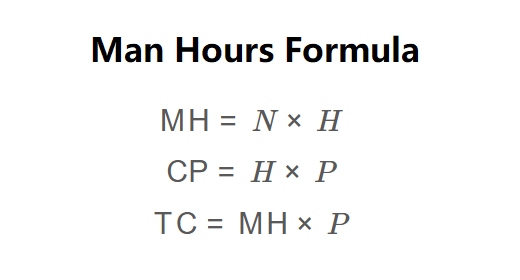 Home
Home
 Back
Back

Definition: The Man-Hours Calculator computes the total man-hours worked on a project, the cost per person, and the total cost based on the number of people, hours each person works, and their hourly pay. Man-hours (also known as person-hours) represent the total labor effort in hours.
Purpose: It helps project managers and businesses estimate labor requirements, calculate individual and total costs, and manage budgets effectively. This tool is essential for project planning, resource allocation, and financial forecasting.
The calculator uses the following formulas, as shown in the image above:
\( \text{MH} = N \times H \)
\( \text{CP} = H \times P \)
\( \text{TC} = \text{MH} \times P \)
Where:
Steps:
Calculating man-hours is essential for:
Example 1: Calculate the man-hours, cost per person, and total cost for a project with 5 people, each working 8 hours at an hourly pay of $20:
Example 2: Calculate the man-hours, cost per person, and total cost for a project with 3 people, each working 35 hours at an hourly pay of $15:
Q: What are man-hours?
A: Man-hours represent the total labor effort in hours, calculated as the number of people multiplied by the hours each person works. It’s a key metric in project management for estimating labor needs.
Q: Does the calculator account for overtime pay?
A: No, this calculator assumes a uniform hourly pay rate. If overtime pay differs, you would need to adjust the hourly pay input or use a separate calculator for overtime calculations.
Q: How can man-hours help improve project efficiency?
A: By tracking man-hours, managers can identify inefficiencies, reallocate resources, and optimize schedules to ensure projects are completed on time and within budget.